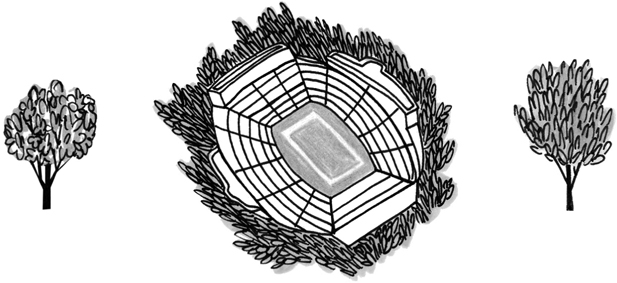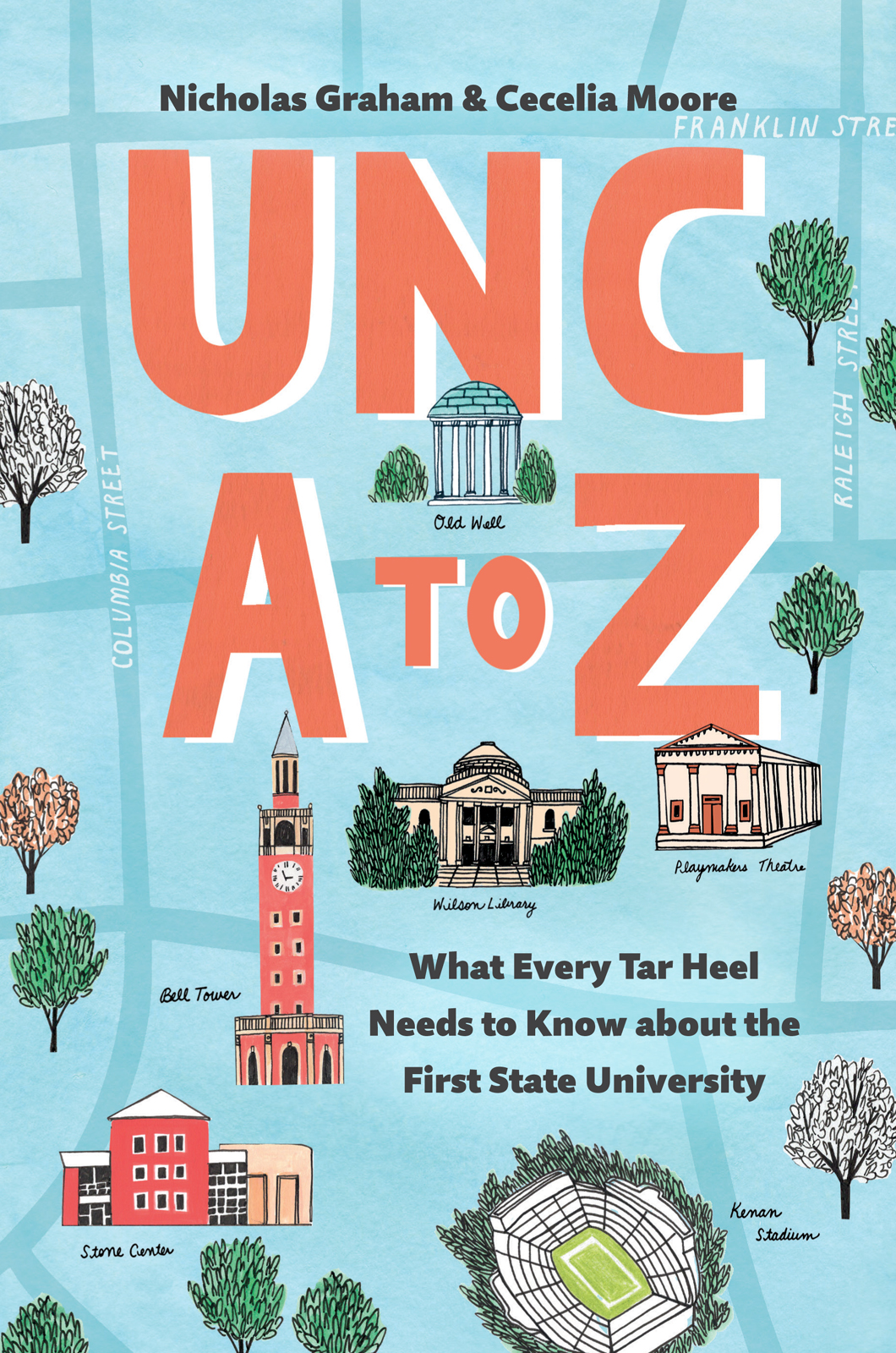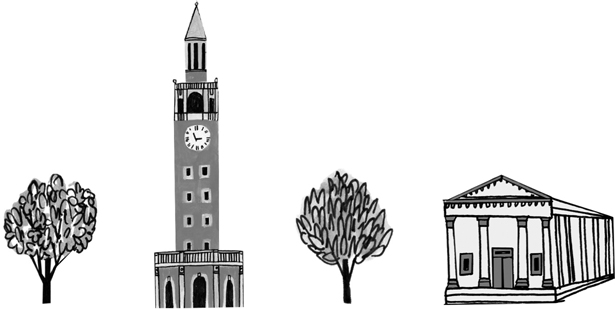UNC A to Z

What Every Tar Heel Needs to Know about the First State University
Nicholas Graham & Cecelia Moore
THE UNIVERSITY OF NORTH CAROLINA PRESS
Chapel Hill
2020 The University of North Carolina Press
All rights reserved
Designed by Jamison Cockerham
Set in Scala, Scala Sans, and Quire Sans Fat by Tseng Information Systems, Inc.
Cover illustration by Kristen Solecki
Manufactured in the United States of America
The University of North Carolina Press has been a member of the Green Press Initiative since 2003.
LIBRARY OF CONGRESS CATALOGING-IN-PUBLICATION DATA
Names: Graham, Nicholas, (Nicholas M.), author. | Moore, Cecelia, author.
Title: UNC A to Z : what every Tar Heel needs to know about the first state university / Nicholas Graham and Cecelia Moore.
Other titles: University of North Carolina A to Z
Description: Chapel Hill : The University of North Carolina Press, 2020. | Includes bibliographical references and index.
Identifiers: LCCN 2019046671 | ISBN 9781469655833 (cloth) | ISBN 9781469655840 (ebook)
Subjects: LCSH: University of North Carolina at Chapel HillHistoryDictionaries. | University of North Carolina at Chapel HillMiscellaneaDictionaries. | University of North Carolina at Chapel HillStudentsSocial life and customs.
Classification: LCC LD3943 .G73 2020 | DDC 378.756/565dc23
LC record available at https://lccn.loc.gov/2019046671
Contents

Introduction
UNC A to Z is a book that we have wanted for a long time. Through our many years of work at Carolina, we have spent a great deal of time working on research projects with students, faculty, administrators, community members, and visiting scholars. Their questions ranged widely across subject matter and time, touching many aspects of UNCChapel Hills more than 225-year history.
Whenever we work on state history, we rely extensively on William S. Powells North Carolina Gazetteer, Dictionary of North Carolina Biography, and Encyclopedia of North Carolina. Researching North Carolina history without those books is unfathomable. Powells reference books and the example he set as a thorough and accessible scholar were inspirations.
Just as we were deeply appreciative of the North Carolina reference trilogy, we were equally frustrated when it came to sources about UNCChapel Hill history. The same questions kept coming up: What are the origins of building names, significant firsts and anniversaries, and student traditions? and Who are the notable faculty, alumni, and administrators who had been at UNCChapel Hill in the past two centuries? We had no single source to turn to. Instead, we combed through published histories, vertical files, newspaper clippings, websites, and official documents. Since we had the resources of the Wilson Library collections at our disposal, we were usually able to get to the answers, but often it was not easy or accomplished quickly. Guided by Bill Powells examples, and in response to the need for a book like this, a need that we see almost every day in our work on campus, we finally decided to write UNC A to Z.
UNC A to Z is a reference book. It was not our intention to introduce a bold, new interpretation of UNCChapel Hill history; nor was it our goal to produce a work that you would sit down and read cover to cover. Though our research has involved extensive use of existing histories and primary sources, this book is not intended to replace the currently available narrative histories of UNC. The book we envisioned would be useful, educational, and fun for anyone who cares for or is curious about Carolina. It is a reference book that readers will be able to open to any page and find interesting, informative stories and facts about UNCChapel Hill history.
Selecting topics to include was one of the hardest parts of this process. We set out to produce a work that was comprehensive but that did not attempt to be exhaustive. All of the major buildings on campus are included, as are many significant groups, events, and traditions. There is a greater representation of recent history in the book because we believe the book will be more useful to todays readers if it addresses the origins and histories behind the university we know today.
Some readers might be surprised to find only a cursory treatment of two significant topics: academics and athletics. In discussing academics, we have included entries for the College of Arts and Sciences and for all of the professional schools. We chose not to include entries for each of UNCChapel Hills many (and often notable) academic departments. The academic work in these departments, spanning decades and in some cases centuries, resists easy summarization. We felt that writing short entries for most academic units would oversimplify their work and leave out too many important people and movements. We refer readers instead to the many published histories of the universitys academic departments and programs. The few programs we do include are those with notable origins or stories that we felt were especially significant in the greater history of the university.
While many different sports and venues are included in UNC A to Z, most are not discussed at length. This is certainly not due to a lack of interest or documentation. Even more so than academic programs, UNCChapel Hill sports are widely covered in a great deal of readily available published information, including histories of the football, basketball, and soccer teams. This also includes a wealth of information shared by the UNCChapel Hill Department of Athletics (the media guides alone are must-reads for anyone interested in Carolina sports history). We decided to focus more of our time on buildings and traditions that are not as well known or as well represented in existing histories.
Following the example of William S. Powells Encyclopedia of North Carolina, we made the difficult decision not to include separate entries about people. A book that attempted to include entries on every prominent faculty member, administrator, athlete, and alumnus would end up being little more than a Whos Who of Carolina history and would be outdated as soon as it was published. We also found that, even without separate biographical entries, many of the most prominent figures in UNCChapel Hill history would still be represented in the book in the entries about buildings, programs, and campus traditions. So while there are no entries specifically about people, important figures like Frank Porter Graham, Wilson Caldwell, Sonja Haynes Stone, and Dean Smith are well represented in UNC A to Z.
Throughout the book, we refer to the University of North Carolina at Chapel Hill using the familiar, shortened terms UNCChapel Hill, Carolina, or simply the university. In acknowledgment of the universitys name change in 1963, when at Chapel Hill was added, references in this book to UNC refer to the university primarily during the period before the creation of the consolidated state university system.










